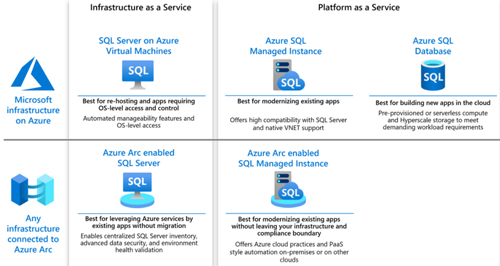News
Azure Arc-Enabled SQL Managed Instance Reaching GA Next Month
Microsoft announced this week that it plans to release a "General Purpose" version of its Azure Arc-enabled SQL Managed Instance (MI) at the "general availability" (GA) commercial-release stage, "starting July 30, 2021."
Azure Arc is Microsoft's multicloud management solution. Azure SQL Managed Instance General Purpose was described by Microsoft as a service used for backups. Earlier this month, Microsoft announced improved performance for Azure SQL Managed Instance General Purpose by adding the ability to back up multiple files in parallel.
The "General Purpose" term refers to Azure SQL Managed Instance's architecture, which separates the compute layer from the storage layer, according to that announcement:
General Purpose is a SQL MI architecture where compute layer (which runs the SQL Server Database Engine process and is being used for query processing & data caching) is separated from the storage layer where all data & log files (.mdf, ldf, .ndf) are placed. The data layer is implemented using Azure Storage that has built-in replication and redundancy that guarantee that the data will be preserved.
General Purpose Not for Backups
However, Azure SQL Managed Instance General Purpose isn't primarily used for backups, according to Andrew Snodgrass, research vice president at Directions on Microsoft (UK). Directions on Microsoft is an independent consultancy and research firm focused on Microsoft technologies and licensing. A research article on Azure SQL Managed Instance (for Directions on Microsoft members) is available at this page.
Azure SQL Managed Instance General Purpose is "a tier of Microsoft's relational database service, based on SQL Server, that operates like an on-premises SQL Server instance," Snodgrass explained, via e-mail. He distinguished it from Microsoft's main Managed Instance and "Business Critical" tiers as follows:
General Purpose has lower IOPs and uses a lower class of processors than Managed Instance. And it doesn't have all the enterprise features of Managed Instance. It also uses Azure Storage for the database, which is good but disconnected so you have some latency issues when accessing data.
Business Critical levels uses much better hardware and has higher IOPs. Importantly, it also uses local SSDs, so the disk read/write performance is fantastic and low latency.
He added that there are three broad Azure SQL product offerings: Azure virtual machines running SQL Server (which is "almost like on-premises"); Azure SQL Database, a platform-as-a-service offering "limited to one database at a time"; and Azure SQL Managed Instance, a platform-as-a-service offering for deploying lots of databases that's "like an on-premises deployment."
Azure Arc-Enabled Data Services
The key to enabling Azure SQL Managed Instance within Azure Arc stems from Microsoft's Azure Arc-enabled data services, listed as being at the preview stage at press time. Organizations wanting to use Azure Arc-enabled data services will need to have "a Kubernetes cluster as the orchestrating fabric in the environment," but they can then run Azure data services "on the hardware of your choice."
Azure Arc-enabled data services lets organizations run Azure data services on "any infrastructure across on-premises data centers, edge, and third-party clouds using Kubernetes on their hardware of choice," Microsoft explained in this 2020 announcement.
Azure Arc-enabled data services lets organizations carry out operations such as automated database management, on-demand scaling of operations, and the ability to set up backup and restore capabilities, among others.
In addition to the coming general availability of Azure Arc-enabled data services support for SQL Managed Instance, a preview is available that adds support for PostgreSQL Hyperscale.
Azure SQL Options
Microsoft last year explained Azure Arc deployment options for Azure SQL Server in this announcement, which included the following useful diagram:
 [Click on image for larger view.] Azure SQL infrastructure-as-a-service and platform-as-a-service options (source: Sept. 30, 2020 Azure blog). The diagram also shows rationales for when to use Azure Arc.
[Click on image for larger view.] Azure SQL infrastructure-as-a-service and platform-as-a-service options (source: Sept. 30, 2020 Azure blog). The diagram also shows rationales for when to use Azure Arc.
According to that diagram, Azure Arc-enabled SQL Server is best for organizations wanting to use existing applications with Azure services, while Azure Arc-enabled SQL Managed Instance is best for organizations wanting to modernize their existing apps.
Azure Arc Partner Support
Perhaps because of all of this complexity, Microsoft touted the availability of its Azure Arc partners in this announcement. Microsoft has an Azure Arc validation program aiming to assure customers.
"We have collaborated with industry-leading OEMs, cloud solution providers (CSP), Kubernetes and OS distribution providers, and independent software vendors (ISVs) to validate their Azure Arc hybrid solutions and deliver the latest innovations and unified management tools for data workloads in any environment," Microsoft explained.
The partner effort is relatively new, as it was "launched at Microsoft Ignite 2021," Microsoft added in another announcement listing Azure Arc technology partners.
Microsoft's case-study example of a customer that is using all of these technologies is rotation-products manufacturer SKF, which claimed in this Microsoft announcement to have reduced costs using Azure Arc.
Microsoft on Tuesday also held online presentations on Azure Arc options for managing Azure SQL backups in its Azure Hybrid and Multicloud Digital Event, which is said to be now available on demand.
About the Author
Kurt Mackie is senior news producer for 1105 Media's Converge360 group.